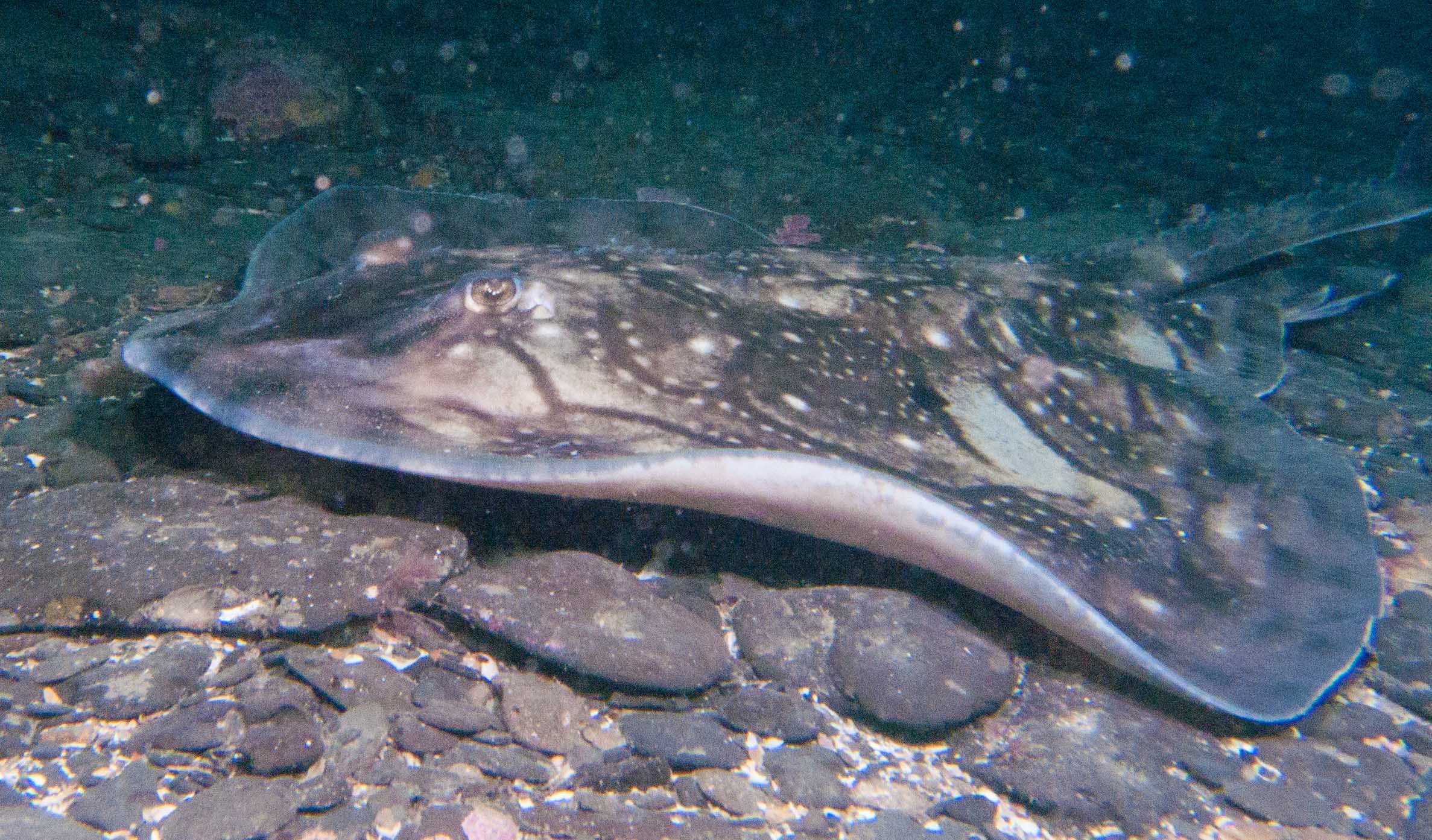Recognizing Undulate Rays
Raja undulata
Martin & Sheilah Openshaw
Abstract
Undulate rays Raja undulata are on the IUCN Red List of Threatened Species however they are distributed in patches along the English Channel with sites of local abundance (Ellis, McCully & Brown 2012). The identification of one particular site in Dorset where Raja undulata are commonly seen provides an opportunity to repeatedly observe them in their natural habitat. Photographic techniques have been used to record the pattern on the upper surface of numerous fish. Using widely available image processing packages, individual rays can be identified with confidence and in several cases their size estimated by use of photographic scales. Repeated diving on the site provides an opportunity to build a body of observations and data. Using the photographic techniques and analysis it is possible to identify individual undulate rays that return to the site over prolonged periods, including fish that have been present in successive years.
Introduction
Undulate rays Raja undulata are generally considered rare and a threatened species but are reported as abundant in patches distributed along the English Channel including Sussex, Poole, around the Isle of Wight, Lyme Bay and the Channel Islands (Ellis, McCully & Brown 2012). They are important for fisheries management because their low fecundity, late maturing and slow growth rate makes them susceptible to over fishing (Cuelho & Erzini 2006). Data on their distribution, size and development is generally developed from fishing, trawl records and limited tagging programs.
As recreational divers, diving along the Dorset coast for 20 years we have come across undulate and other species of rays on numerous occasions. These have been isolated occasions without any particular pattern and would appear to match the experience of other divers who occasional report seeing rays along this coastline. In 2012 during a series of dives in one specific area, one or more rays were seen on almost every occasion, sufficiently unusual to merit further investigation.

The Site
The site forms part of Kimmeridge Ledges, a series of shallow ledges reaching out to sea for up to a mile that have caught many sailors unaware and been the cause of numerous shipwrecks. With each ledge the seabed rises towards the surface, creating a series of wide shallow valleys between each pair and a variety of habitats for sea life. The area observed is approximately 50-metres wide and over 200-metres north to south, a extremely small area on the south coastline but being roughly the size of two football fields is an extensive area to cover by a diving activity. Numerous dives in the summer periods from 2012 to 2014 have provided the opportunity to observe undulate rays in their natural environment and we are not aware of records existing of similar congregations of undulate rays in a particular place.
The Rays
The rays are found resting on the seabed and although some can be quite skittish and will dart or, more likely, gracefully swim away as a diver approaches, others are comparatively placid and can be approached with care. In most cases where an undulate ray is seen, it is possible to get very close, photograph the fish and in many cases, place a photographic scale close by to give an indication of size.

The undulate rays vary in colour from predominantly brown through greyish-brown to predominantly grey. They are patterned with wavy, undulating dark bands and varying amounts and sizes of white spots. In 1926, Robert Selby Clark reported that “In the examination of thousands of Rays, I have never met with examples which have been perfectly symmetrical.” (Clark, R.S. 1926). This comment was relating to the size and shape of undulate rays however the pattern of bands and spots is also asymmetrical and seen to be unique to the individual fish. By comparison of photographs showing the pattern and marking, single individual fish can be identified with confidence and matched to previous sightings of the same ray. Obtaining a good quality image of a ray underwater in UK conditions is however not necessarily easy. Visibility can vary dramatically from 15+ metres (easy) to 2 or less metres (not easy). The diver needs to be mid water, 1 or 2 metres above the fish and there will generally be some tide movement pushing the diver along; attempts to stay stable in one position are likely to disturb the ray causing it to swim away, along with any chance of obtaining a photograph.
To get the full width of the ray in the frame of the photograph requires the camera to be some distance above the fish. At this distance in UK waters, there is inevitably a considerable amount of material in suspension between the camera and the fish, any use of the built in flash therefore causes a large amount of backscatter, obscuring the subject of the photograph. Trying to overcome this with more elaborate equipment means that more care must be taken not to disturb the fish.
Under these conditions, we have had most success getting overall images of the fish by using a small, relatively low-cost compact camera, with natural light. Often this produces dark, greenish images of little photographic merit like the example “Garay sighting A as taken” (Figure 3) but these can easily be processed by readily available software to highlight the pattern and marking.

Once processed in this way, the photographic merit of the original photograph is mostly lost as shown by comparing the “as taken” and “processed” examples of the two sightings A and B. By detailed comparison of the pattern with particular attention to the asymmetry of individual markings on the fish it is possible to identify individual undulate rays with confidence. More information is available on the image processing and identification technique on the website http://www.stardis.co.uk/ray_id.html.
One hundred and eighteen encounters have been recorded, the majority of these (97) being with undulate rays Raja undulata.
Table 1: Sighting of all rays between 2012 and 2014
From the ninety seven undulate rays, ten individuals have been seen and subsequently identified, several days or weeks later. This brings the total to seventy three individual undulate rays that have been recorded and photographed on this site between 2012 and 2014. Four of the ten individuals have been seen on separate years.
One individual, named “Billy” has been recorded on at least one occasion each year during the three year period and 3 times in 2013. “Billy” was first identified as an individual in 2013 when he was seen and photographed on 3 successive occasions across a 2-month period from the end of June to the end of August. He was named after Billy Bones from Robert Louis Stevenson’s Treasure Island because of a distinctive black spot on his left wing. Billy is a mature male with a wingspan (disc diameter) of almost 50-cm and an overall length of approximately 90-cm. He was photographed on the same site in July 2012 and was subsequently photographed in August 2014. Hence he has been in the vicinity or visited the same site over 3 consecutive years.
Table 2: Sighting of undulate rays
Summary
Although the data remains insufficient to draw firm conclusions, the following observations would appear relevant. Given the few occasions that divers visit the site over the three year period, the occurrence of repeat sightings at approximately 1 in 7 suggests the rays represent a relatively small population that visit the same area/site on a regular basis. They appear to be resting during the day, often remaining in the same position for several hours but why they are in the area remains unknown.
We know the rays are not always there but we have no knowledge of where they go, how frequently they may visit the site, how far they may travel, whether they remain close by between sightings or whether they visit on occasional days as part of much wider travelling pattern. Hopefully more information gathered from this site, the possible identification of similar sites will compliment other research studies and provide answers to some of these unknowns.

Fig. 5: 'Billy'
References
The IUCN Red List of Threatened Species. Version 2014.3. http://www.iucnredlist.org. Downloaded on 15 March 2015.
Ellis, J. R., McCully, S.R., and Brown, M.J. 2012. An overview of the biology and status of undulate ray Raja undulata in the north-east Atlantic Ocean. Journal of Fish Biology (2012) 80, 1057–1074.
Cuelho, R. and Erzini, K. 2006. Reproductive aspects of the undulate ray, Raja undulata, from the south coast of Portugal. Science Direct Fisheries Research 81 (2006) 80-85.
Clark, R.S. 1926 Rays and skates: a revision of the European species. HMSO publication 1926.



